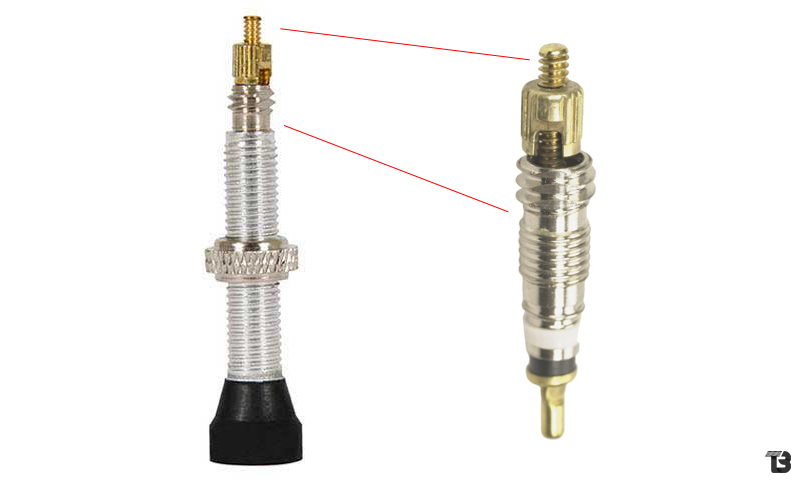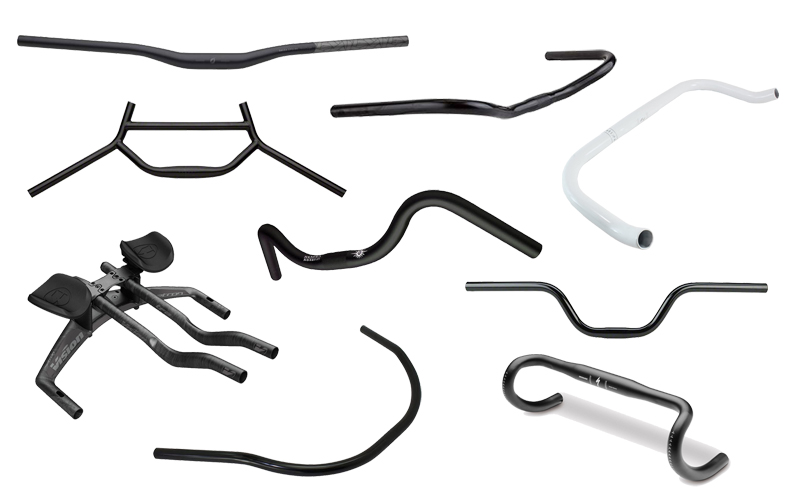How Do Tubeless Valve Stems Work?
Have you ever wondered how tubeless bicycle valves work? What about whether or not you should spend your hard-earned money upgrading to a ‘no-clog’ model?
In this article, we’ll briefly outline essential details like the high-level differences between standard and tubeless bike valves, as well as how you can reduce clogged valves on your tubeless setup. First, though, let’s cover some basics.
The Basics About Bicycle Tire Valves Stems
A bicycle tire valve consists of an inner core that opens when external air pressure is applied (such as via a pump), but which is held shut by the air pressure inside the tire.
In How to Buy Your Next Bike Pump, we explain that there are two popular types of bicycle-related valves used by today’s cycling manufacturers:
- Schrader (aka American) – Commonly found on automobiles, motorcycles, and industrial equipment, these valves utilize an internally-threaded, spring-assisted valve core that’s surrounded by a rubber seal to prevent fluid from escaping.
- Presta – Valves that feature a taller, thinner profile, with a small nut at the top of the body that remains in place, even if fully unscrewed (known as ‘captive’). This nut also prevents airflow once closed. A second nut threads over the valve’s body and tightens against the rim. Many models also feature removable/replaceable cores (more soon).
In most instances, Schrader or Presta valves are permanently attached to a butyl rubber inner tube. After fitting the valve through a hole on the underside of a bike’s rim and attaching it a pump, these torus-shaped tubes wedge between the rim and the tire and provide cushioning while riding.
The problem, as anyone who’s ridden a bicycle long enough will attest, is that inner tubes are prone to puncture and air loss, which can quickly ruin even the best rides. But, how can we remove inner tubes from the equation while maintaining an airtight seal between the rim and the tire? Let’s continue in the next section.
Regular Bike Tire Valves vs. Tubeless Valve Stems
Without an inner tube, a tubeless valve relies on a small rubber base attached at its back to maintain air pressure inside tires. Riders often add a small amount of liquid sealant inside the tire, such as Orange Seal or Stan’s NoTubes, which feature nanoparticles that are immediately pulled to holes as air escapes, and then quickly coalesce to prevent additional air from escaping.
Related: How Tubeless Tires Work
In most instances, tubeless setups utilize Presta valves for two commonly-accepted reasons:
- The valve body’s exterior is threaded, which allows for the addition of an external nut that tightens against the rim and further seals the rubber base into its hole.
- Although it’s certainly not universal, Presta valves also often feature removable valve cores for ease of maintenance.

As BikeRadar’s Billy Eich argues, though, the rationale behind Presta’s carte blanche within the tubeless world has come under scrutiny as the cycling industry grows, since Schrader valves are more common, offer greater durability, and perhaps most importantly, are increasingly available with removable cores.
But, why are removable cores such a big deal? First, with its core removed, a tubeless valve can accommodate greater airflow, which is a considerable advantage when seating tubeless tires on rims.
Second, whether Schrader or Presta, the problem with most commercially available tubeless setups is that the sealant is a little too good at its job. In other words, the same chemical reaction that quickly plugs holes in your tires and prevents too much air from leaking is the same one that eventually clogs your valve’s core, regardless of the brand.
Instead, with a removable core, you can simply unthread it from the valve’s body and clean or replace it, instead of changing out the entire valve altogether, which could quickly become expensive and time-intensive.
With these details in mind, can you buy tubeless bicycle valves that resist clogging?
What’s the Difference Between Standard Tubeless Valves & No-Clog Valves?
Like any other cycling product, you’ll find minor design differences between tubeless models from different manufacturers, even when it comes to something as simple as a valve. For example, type ‘no-clog tubeless valves’ into your favorite search engine, and you’ll find versions like the Industry Nine No-Clog Aluminum Tubeless Valves, which boast a higher interior lip, purportedly to help reduce sealant from over-splashing and reaching the core.
Let’s keep it real, though: we’re only talking about the difference of a few millimeters here. Added to the fact that ‘no-clog’ valves also feature the same diameter as any other Presta valve and, by all appearances, are compatible with the same aftermarket cores, there doesn’t seem to be anything necessarily unique about ‘no-clog’ tubeless bicycle valves that might make them less susceptible to clogging caused by sealant.
How Can You Prevent Clogged Tubeless Valves?
It’s not all doom and gloom when it comes to tubeless setups and clogging, though. Here are a handful of simple ideas you use to help increase the serviceable life of your tubeless valves:
- Rub silicone or synthetic grease onto the core’s threads, shaft, and pin (I’ve even seen riders recommend a few drops of Effetto Caffelatex Remover). Not only can this help prevent clogs, but it can also make your cores easier to remove when the time comes.
- Orange Seal recommends parking your bike with your valves between the 9:00 and 3:00 positions, which pools sealant at the opposite end of your tires. You can also maintain this positioning while inflating your tires.
- Many riders swear they’ve never experienced a clogged valve after breaking the seal against their tire’s bead, and then manually pouring in the sealant and reinflating, instead of adding sealant through the valve’s body.
Are your valves already clogged? Here are some handy ideas that can help you regain airflow:
- After removing your core, blast it with a shot of air from a compressor.
- Wipe thoroughly with a paper towel. Just make sure that you don’t leave behind small pieces of paper.
- Soak for several hours in soap and warm water. Or, if you want to get serious, you can use gasoline, naphtha, or ammonia.
- Manually pick the sealant from the valve core using an unwound wire coat hanger.
If nothing else, the reality is that replacement valve cores are relatively inexpensive when purchased in bulk (10+) from dozens of online retailers, which are always good to have around in case something goes wrong.
Bottom Line: Do You Need Tubeless or No-Clog Bike Tire Valves?
If you’re converting your bicycle to tubeless, the fact of the matter is that you’ll have to purchase compatible valves that retain an airtight seal in the absence of rubber inner tubes. When it comes to the specific design and manufacturer, though, much of that decision will hinge on your needs and preferences.
With this said, based on my experience, as well as reading the experiences of other cyclists online, you probably won’t eliminate gunked-up valves by buying ‘no-clog’ models.
Still, at just $20 or so, these models might slow the process and decrease the time and effort required to inflate tires, especially as the valves become increasingly clogged. Then, you can spend that time and energy doing other things, like enjoying the great outdoors on your bike.
Furthermore, aftermarket tubeless valves typically feature attractive anodized aluminum finishes that can add some bling to your cycling setup. And who doesn’t need that in their life nowadays?
Which tubeless valves do you prefer? What kinds of experiences have you had with ‘no-clog’ tubeless valves? Share your knowledge by leaving a comment below!



